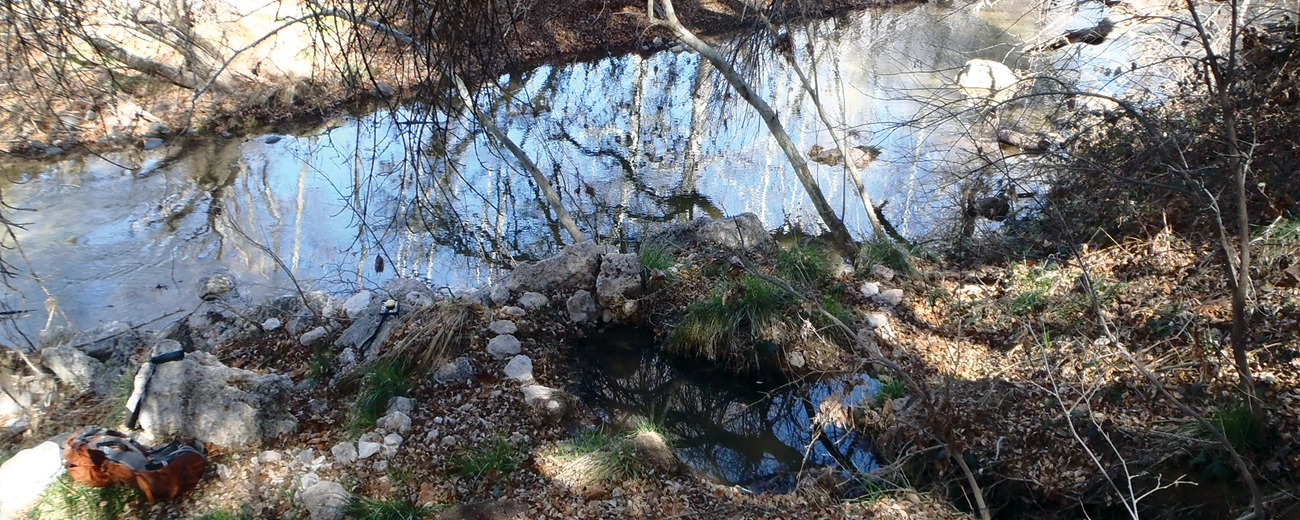Last updated: November 16, 2025
Article
Climate and Water Monitoring at Montezuma Castle and Tuzigoot National Monuments, 2018

Climate, groundwater, and surface water are closely related. At Montezuma Castle and Tuzigoot national monuments, the Sonoran Desert Network monitors all three to track broad-scale change and provide early warning of potential problems.
Background
Many National Park Service units in the U.S. Southwest were established to protect precious cultural resources. In most cases, however, the surrounding natural environment is an equally significant part of the story. At Montezuma Castle and Tuzigoot national monuments, in central Arizona, the remains of the precontact built environment reflect the importance of reliable water sources.
At Montezuma Castle National Monument, the cliff dwellings of the Castle unit overlook the perennial waters of Beaver Creek. The Sinagua people inhabited this riparian oasis for over 400 years. At the nearby Well unit, cliff dwellings nestled just below the rim of the well—a huge limestone sinkhole—are testament to the value of the site, still considered sacred by many local tribes. Wet Beaver Creek flows through the Well unit, joining Beaver Creek a few miles downstream. Both are tributaries of the Verde River, which passes through nearby Tuzigoot National Monument. The stream segment within Tuzigoot lies below an agricultural dam that diverts all but about 14% of the river’s flow. At both parks, springs also contribute to perennial surface waters.
The Sonoran Desert Network monitors groundwater, springs, and streams at Montezuma Castle and Tuzigoot national monuments. The goal of the program is to detect broad-scale changes in ecological condition by observing certain parameters over time—and to give park managers early warning of any issues they may need to address.
Hydrologic conditions are closely related to climate conditions. Because the two are better understood together, the Sonoran Desert Network reports on climate in conjunction with water resources. Reporting is done by water year (WY), which begins in October and ends the following September.

Recent Findings (Water Year 2018)
Climate
Water year 2018 was hotter and drier than normal. Overall annual precipitation was 49% of normal for Montezuma Castle National Monument (NM) and 76% of normal for Tuzigoot NM. Rainfall in fall and winter was extremely low. Mean monthly maximum temperatures at both parks were above normal for all months except one at Montezuma Castle. Tuzigoot NM showed a return to drought conditions following recent wetter years. Additional information can be found at The Climate Analyzer.
Groundwater
Groundwater levels at the water-supply wells for both units of Montezuma Castle National Monument declined from WY2017, by 24.20 (Castle unit) and 8.10 (Well unit) feet, respectively. However, both wells had been recently pumped, so those values may not represent actual conditions. Over the monitoring record, water levels at the Castle unit have been variable, while water levels at the Well unit have generally declined. Groundwater levels in the three monitoring wells near Tuzigoot National Monument showed variable changes from water year 2017. All three wells have shown relatively stable groundwater levels since 1999.
Springs
Expansion Spring (Montezuma Castle NM Castle unit) and Shea Spring (Tuzigoot NM) were both classified as “undisturbed,” despite some evidence of beaver activity at Shea Spring. Sensors indicated that both springs were likely wetted throughout the sampling period.

Streams
Streamflow
The lack of precipitation was reflected in the parks’ low streamflow in WY2018. Mean daily discharge from the Beaver Creek station was 7.13 cubic feet per second (cfs)—approximately one-tenth of the mean value from WY2005 to 2008. At Wet Beaver Creek, mean daily discharge was 7.05 cfs, well below the gage record mean of 30.2 cfs. Recorded flow at the Verde River gage was either at or below the 25th percentile for most of the year. There was a striking lack of flow events at all sites. There was no snowmelt pulse observed in the hydrographs for Wet Beaver Creek and the Verde River this year.
Water Quality
There were 10 exceedances of water-quality standards during WY2018: seven on Beaver Creek (one E. coli, three dissolved oxygen, and three total arsenic), one on Wet Beaver Creek (total arsenic), and two on the Verde River (one E. coli and one total lead). This resulted in a 94% compliance rate across the three units.
| Water body | Park | Standard exceeded |
|---|---|---|
| Beaver Creek | Montezuma Castle NM (Castle unit) | E. coli (1) Dissolved oxygen (3) Total arsenic (3) |
| Wet Beaver Creek | Montezuma Castle NM (Well unit) | Total arsenic (1) |
| Verde River | Tuzigoot NM | E. coli (1) Total lead (1) |
Macroinvertebrates and Fish
Macroinvertebrate index values for warmwater streams were likely attaining at all sample sites. The values for Beaver and Wet Beaver Creek were the highest recorded by SODN. This was good news after several years of either not attaining or scoring in the inconclusive category.
Past Findings
Climate and Water Monitoring at Montezuma Castle and Tuzigoot National Monuments, 2017
Information in this brief was summarized from E. L. Gwilliam, L. Palacios, and K. Raymond. 2019. Status of climate and water resources at Montezuma Castle and Tuzigoot national monuments: Water year 2018.
